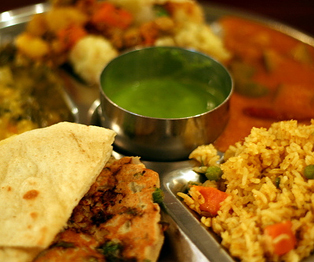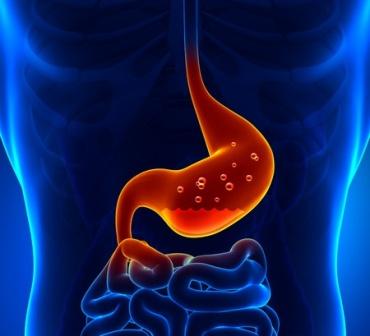Common Food Related Issues In Indian Vegetarians
- Proteins

image by mocmoc Calories
- Vitamin B12
- Iron
- Bloating
- Food poisoning
Indian Plant Foods High in PROTEINS
Amount of proteins in 100g (except specified otherwise) of food:
- Pulses (cooked)
- Lentils, Masoor dal = 9g
- Pigeon peas, red gram, Toor dal = 7g
- Black lentils, black gram, Urad dal = 7g
- Chickpeas, Bengal gram, Channa dal = 9g
- Soybean, cooked = 12 g
- Tofu = 9g
- Soymilk (one cup, 243 g) = 8g
- Kidney beans = 9g
- Green peas = 5g
- Nuts: 21-24g
- Ground nuts, peanuts, arachides, Moongfali, roasted = 24g
- Peanut butter (2 tbsp) = 8g
- Pistachios, Pista = 21g
- Walnuts (Akhroat/Akhrot), dried = 24g
- Almonds (Badam), roasted = 21g
- Cashew nuts (Kaju) = 15g
- Cereals: 6-13 g proteins
- Indian flatbread, Roti = 11g
Vegetables and fruits contain less than 5g proteins per 100g of food.
Prepared Indian foods high in proteins:
- South Indian Pepper water soup (Rasam), 100 g of prepared soup with 50g peas and 50g tomatoes contains around 22g proteins.
- Black Gram snack (Medu vada), cooked; contains 24g proteins per 100g of food.
- Cashew Sweet Balls (Badam mithai), nuts and jaggery, cooked; contains 18g proteins per 100g of food.
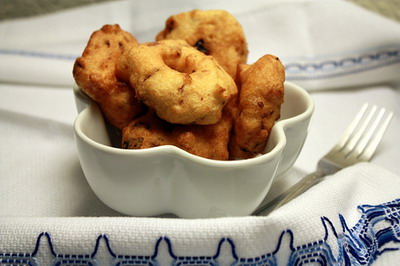
proteins are main building elements of the human body and have several functions; they are a part of essential substances like antibodies, hemoglobin, enzymes, hormones and coagulation factors. Vegetarians can usually get enough proteins from plant food, but when they do not, the following symptoms of protein deficiency may appear:
- General weakness
- Headache
- Thinning of the hair and skin
- Weight loss
- In extreme protein deficiency, known as Kwashiorkor, swelling of the abdomen, seen mainly in children from poor areas, may (rarely) occur.
Essential Amino Acids
Essential amino acids are those, which cannot be synthesized by the human body, so we need to get them from food. Certain plants typically do not contain all essential amino acids, but with combining various plant foods a vegetarian can get all essential amino acids without worrying much.
Indian Plant Foods High in UNSATURATED FATS
Foods high in unsaturated fats:
- Avocados
- Olives
- Walnuts
- Flax seed (linseed) oil, rapeseed (canola) oil, peanut oil, olive oil, soy oil
Unsaturated fats may lower blood levels of ‘bad’ LDL cholesterol.
On the other hand, saturated fats (in coconut chutney or oil) or trans-fats (in hydrogenated oil, like Dalda, and in margarines) may raise LDL cholesterol. Large amounts of saturated fats are also in cheese and ghee.
Indian Foods High in CARBOHYDRATES
Amount of starch in one serving of prepared food:
- Rice, white, cooked (one cup, 158g) = 45g
- Jowar roti, baked = 34g
- Chickpea, whole Bengal gram, cooked (one cup, 164g) = 25g starch (and 8g sugar)
Starch is a preferable source of carbohydrates and preferable source of calories. Vegetarian diet should contain at least 50% of starch.
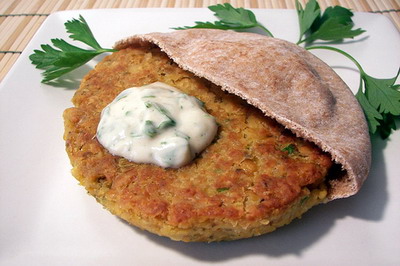
Amount of sugars in 100 g of food:
- Honey = 79g
- Jaggery = 70g
- Dried dates = 66g
- Raisins = 59g
- Dried figs = 48g
- Plums = 38g
- Grapes = 16g
- Mango = 15g
Diet high in sugars can raise blood levels of LDL cholesterol, thus increasing the risk for heart disease. High sugar diet can also result in diabetes type 2.
Above mentioned foods are high in fructose, and can cause abdominal bloating and diarrhea, if eaten in excess, since only about 20-30 grams of fructose per meal can be absorbed in the small intestine.
Indian Foods Rich in Dietary Fiber
Dietary fiber adds bulk to the stool thus help to maintain regular bowel movements.
Examples of Indian meals high in fiber:
- Dosa with Lima beans (100g ) = 19 g fiber
- Indian bread mixed with potato and beans (Dosa), (100 g) = 6 g fiber
Foods Rich in SOLUBLE Fiber
- Oat bran (100 g) = 5.0 g
- Apple (1 small) = 2.3 g
- Potatoes (1 small) = 2.2 g
- Peas (125 ml), cooked = 2.0 g
- Brown rice (125 mL), cooked = 1.3 g
- Rolled Oats (187.5 mL), cooked = 1.3 g
- Orange (1 medium) = 1.3 g
- Carrots (1 large) = 1.3 g
- Grapefruit (1/2 fruit) = 0.90 g
Soluble fiber can help to maintain steady levels of blood glucose in diabetics. It can also help to reduce a level of LDL cholesterol a bit. Soluble fiber, if taken in excess, can cause abdominal bloating and excessive gas (flatulence).
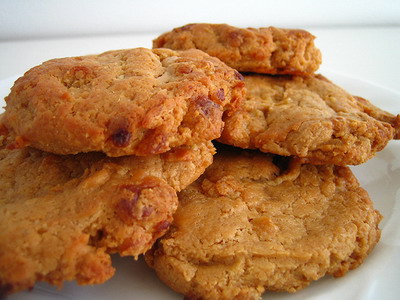
Foods Rich in INSOLUBLE FIBER
- Bran (100%) cereal (125 mL) – 9.7 g
- Peas (125 mL), cooked – 3.2 g
- Whole grain bread (1 slice) – 2.8 g
- Apple (1 small) – 1.6 g
- Carrots (1 large) – 1.6 g
- Potatoes (1 small), cooked – 1.6 g
- Corn (187.5 mL) – 1.4 g
Insoluble fiber should not cause excessive gas.
Plant Foods Rich in Vitamin B12
Commercial plant foods enriched with vitamin B12:
- Vit B12 enriched morning cereals – read labels for the amount
- Vit B12 enriched margarine. Margarine contains trans-fats, which may raise blood level of LDL cholesterol, so this is not a preferable source of vitamin B12 for vegetarians
Vitamin B12 is not found in foods of vegetable origin but only in animal sources like eggs, milk and cheese.
Deficiency of vitamin B12 may lead to megaloblastic anaemia (pernicious anaemia), damage of nerves (unusual sensations, like tingling being one of the first symptoms). Dietary deficiency of B12 may be a problem for vegans, who eat strictly plant foods. Vitamin B12 rich foods are appropriate for prevention of vitamin B12 deficiency, but not for its treatment (vit B12 supplements should be taken in this case).
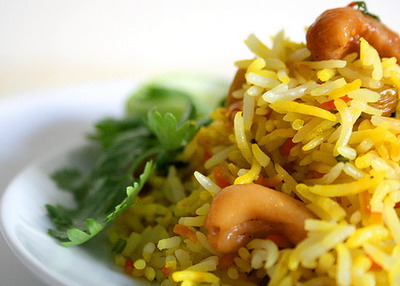
Plant Foods Rich in IRON
Vegetarians, especially women, often develop iron deficiency, since plant sources of iron are not absorbed as god as animal sources.
- Soybeans (125 mL), cooked – 4.4 mg
- Baked Potato with skin (125 mL), cooked – 1.7 mg
- One large potato – 1.4 mg
- Sunflower seeds (125 mL), cooked – 1.2 mg
- Sesame (125 mL), cooked – 1.2 mg
- Cashew nuts (125 mL), cooked – 1.0 mg
- Whole wheat bread (one slice) – 0.9 mg
- White bread (one slice) – 0.7 mg
- Juice of tomato (125 mL), cooked – 0.6 mg
Prepared Indian foods rich in iron:
- The curry made from drumstick or horseradish leaves (Murungai keerai). Almost 50 mg iron is present in one serving (100g). Drumstick curry recipes and pictures.
- Finger Millet cakes (Ragi idli), (100 g) contains lots of carbohydrates and iron – about 40 milligrams. Ragi idli recipes and pictures.
- Cooked Rice (Biryani) contains iron rich vegetables. Mixing it with iron rich vegetables like corn, potatoes, spinach, broccoli and peppers makes it a healthy iron filled dish. 100 g spinach contains 4 mg iron, broccoli 3 mg and potatoes 4 mg. Biryani recipes and pictures.
Foods rich in iron are appropriate to prevent iron deficiency anemia, but not to treat it – in anemia, iron supplements should be taken.
Points to Remember About Indian Vegetarian Foods
that vegetarians eat
- Animal foods, like milk, cheese, eggs (yolk) and ghee are high in saturated fats, which are a risk factor for a heart disease in susceptible individuals
- Coconut meat and oil and coconut chutney are high in saturated fats
- Hydrogenated oils in margarine and Dalda can raise LDL cholesterol
- Vegetarians who do not eat dairy products should not worry about calcium and vitamin D. Calcium is practically in any plant food, and enough of vitamin D is synthesized in the skin during regular sun exposure.
- Indian fruits and vegetables are often eaten raw, what raises a risk of food poisoning with bacteria and parasites, resulting in diarrhea. For this reason, all fresh plant foods have to be thoroughly rinsed under the tap water.
References:
- Nutrition facts from Nutritiondata

